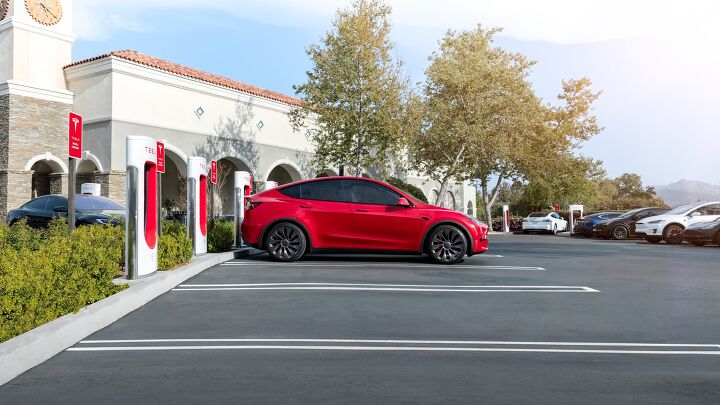Tesla Begins Charging $1 Per Minute Congestion Fees at Busy Superchargers

Tesla recently started opening its Supercharger network to outside EV brands, but the influx of more vehicles to charge has put a strain on the system. To help with the surge, the automaker has started charging congestion fees of up to $1 per minute at busy Supercharger locations.
The fee is intended to get drivers in and out of the charging stations faster by making it more expensive to charge to 100 percent. Some Superchargers already charge an idle fee that discourages leaving a fully- or almost fully-charged vehicle plugged in for too long, and the new congestion fee starts once a vehicle has reached 90 percent.
Tesla’s Supercharger network is set to become the standard for several major automotive OEMs in the coming years. Ford, General Motors, and many others have announced plans to adopt Tesla’s North American Charging Standard (NACS), so the Supercharger network will only become busier as time goes on.
Tesla hasn’t offered details on where and when the fees would be implemented, only saying that “certain” chargers will have the fee. Though annoying for some, the charges will likely be a good thing for congestion, as some new owners aren’t quite up to speed on charging etiquette. Anything that encourages moving along when the vehicle reaches a somewhat acceptable state of charge will be a positive thing for everyone at the location.
[Image: Tesla]
Become a TTAC insider. Get the latest news, features, TTAC takes, and everything else that gets to the truth about cars first by subscribing to our newsletter.

Chris grew up in, under, and around cars, but took the long way around to becoming an automotive writer. After a career in technology consulting and a trip through business school, Chris began writing about the automotive industry as a way to reconnect with his passion and get behind the wheel of a new car every week. He focuses on taking complex industry stories and making them digestible by any reader. Just don’t expect him to stay away from high-mileage Porsches.
More by Chris Teague


































Comments
Join the conversation
Tesla owners are kind of the new BMW owners: They know the etiquette, they just don't care.
Only when there's enough power to run it.
"Fill 'er Up!" Another well worn phrase destined for the dustbin. Who gets to set the limits? Elon? The Feds? A 3rd party? What determines peak usage? Last year the US was going to have a zillion chargers on every corner. When that turned out to be both very expensive and almost impossible, the next step is to limit charging? Thereby limit usage and range? No Thanks. Keeping my gas engine cars and passing them all down to me kids. They may need to actually get somewhere someday.
Tesla built an artificial charging network: they built it because they couldn’t make an argument for their cars without it. But I’ll bet it’s overall a money pit. The land they sit on and the space they occupy is not free. The electricity and infrastructure to build a row of superchargers is not cheap - you need a hell of a big transformer to fully power multiple chargers. And I’m guessing the utilization rate is very poor - of the chargers I see they are hardly ever occupied. And I would further speculate that usage has predictable peaks. You would think the best place to put a supercharger would be a gas station, but they need too much real estate to make economic sense. I’d like to see real numbers but I’m guessing the economics of larger charging “plazas” just doesn’t begin to work, unless the electricity is very, very expensive. The second car, the in town usage model, where you always charge primarily at home and occasionally on a Level 2 at your destination is the only solution that really makes sense. And this means the electric cats will remain niche. Your second car, the one you can live without, your extra car that rarely wanders far from home. All I see are pickup trucks wherever I go. EV’s will never replace them, right, wrong or indifferent.